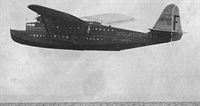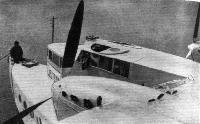
Описание
Страна : Франция
Год : 1935
Летающая лодка
Единственный экземпляр
Дальняя морская патрульная летающая лодка
Latecoere 521, 522 и 523
Гигантская летающая лодка Latecoere 521, построенная на базе четырехмоторного Latecoere 520 и получившая собственное имя "Lieutenant de Vaisseau Paris", проектировалась для совершения пассажирских трансатлантических полетов. Самолет оснащался шестью V-образными двигателями Hispano-Suiza 12Ybrs-2 мощностью по 650 л. с. - внешние два мотора были одиночными, а внутренние устанавливались тандемно и приводили в движение толкающие и тянущие воздушные винты. Двигатели устанавливались в гондолах под верхним крылом. Нижнее крыло малого размаха соединялось с основным крылом при помощи стоек, а к самому малому крылу, в свою очередь, крепились стабилизирующие поплавки.
В носовой части двухреданного корпуса имелось швартовочное оборудование, за которым располагались нижняя палуба с радионавигационным отделением, салоном на 20 пассажиров, шестью кабинами класса "люкс", еще одним салоном на 26 пассажиров, кухней и багажным отделением. На верхней палубе находились кабина управления, отсек бортинженера, а также салон на 18 пассажиров и второе багажное отделение.
После своего первого полета 10 января 1935 года самолет Latecoere 521 совершил несколько демонстрационных полетов, после чего в декабре 1935 года вылетел в Дакар (Западная Африка), откуда проследовал в Натал (Бразилия) и затем во Французскую Вест-Индию. 13 января 1936 года самолет достиг Пенсаколы, штат Флорида, где его застал ураган - самолет, в итоге, затонул на якорной стоянке. Поднятая и возвращенная во Францию летающая лодка была перестроена для компании "Air France Transatlantique" и снова поднялась в воздух в июне 1937 года. Позднее самолет совершил беспосадочный перелет в Бразилию, а затем перелет с промежуточными посадками через Северную Атлантику; обратный полет в сентябре 1937 года был уже беспосадочным.
С более мощными двигателями с мая по июль 1939 года самолет совершил четыре полета с промежуточными посадками до Нью-Йорка и обратно, а затем самолетом заинтересовались ВМС Франции - машину включили в состав эскадрильи E.6 и использовали в качестве дальнего патрульного самолета в водах Северной Атлантики. В июне 1940 года самолет оказался в Порт-Лиоте на атлантическом побережье Марокко, но вскоре вернулся в Берре (Южная Франция). Там в августе 1944 года машина была разобрана.
Успех самолета привел к тому, что были размещены заказы еще на три гражданских Latecoere 522 и три военных Latecoere 523. Из гражданских построена была только одна летающая лодка Latecoere 522, получившая имя "Ville de Saint Pierre". Самолет прошел испытания в апреле 1939 года, он существенно отличался от Latecoere 521: верхняя часть корпуса была перепроектирована, изменили размещение пассажиров, увеличили максимальную взлетную массу, а в состав силовой установки включили двигатели Hispano-Suiza 12Y36/37 мощностью по 920 л. с.
До начала Второй мировой войны данной машиной было совершено два двойных перелета через Северную Атлантику, а затем самолет был реквизирован военными и передан патрульной эскадрилье E.6, дислоцированной в Ланве-ок-Пулмик (около Бреста). Самолет Latecoere 522 получил повреждения во время полета во Французское Сомали в феврале 1941 года, после чего вернулся во Францию, где и был разобран в августе 1944 года.
Три самолета Latecoere 523 были поставлены в эскадрилью E.6, первый из них, названный "Altair", совершил первый вылет 21 октября 1938 года. В целом самолет напоминал модель Latecoere 522, имел экипаж из 14 человек, вооружался пятью 7,5-мм пулеметами Darne и мог брать до 1350 кг бомб. Самолеты применялись для патрулирования над Атлантикой, лишь один из них пережил вторжение Вермахта в июне 1940 года и после ремонта был передан ВВС правительства Виши - машину передали эскадрилье 4.E и передислоцировали в Дакар, где она и была брошена в августе 1942 года ввиду отсутствия запчастей.
ТАКТИКО-ТЕХНИЧЕСКИЕ ХАРАКТЕРИСТИКИ
Latecoere 523
Тип: дальняя морская патрульная летающая лодка
Силовая установка: шесть V-образных 12-цилиндровых двигателей с водяным охлаждением Hispano-Suiza 12Y-27 мощностью по 900 л. с. (671 кВт)
Летные характеристики: максимальная скорость 261 км/ч: практический потолок 6300 м: максимальная дальность 4100 км
Масса: пустого снаряженного 20840 кг; максимальная взлетная 42 000 кг
Размеры: размах крыла 49,31 м; длина 31,62 м; высота 9,70 м; площадь крыла 329,99 мг
Вооружение: один 7,5-мм пулемет Darne в надфюзеляжной установке и четыре таких же пулемета в бортовых установках, плюс четыре 150-кг и восемь 75-кг бомб на держателях, размещенных на нижнем малом крыле
Описание:
- Latecoere 521, 522 и 523
- Flight, January 1935
THIRTY-SEVEN TONS in the AIR
Фотографии
-
Мировая Авиация 168
Latecoere 521, названный "Lieutenant de Vaisseau Paris", мог брать до 72 пассажиров и в комфортабельных условиях перевозить их через Атлантику.
-
Aeroplane Monthly 1993-06 / R.Esperou - French atlantic wings (1)
The 161ft 9 1/4in-span Latecoere 521 had a gross weight of 81,570lb and a cruising speed of 130 m.p.h. It is seen moored at Biscarosse in early 1935.
-
Aeroplane Monthly 1993-06 / R.Esperou - French atlantic wings (1)
Early in 1935 the Latecoere is ready to take to the water at Biscarrosse, mounted on its special launching dolly.
-
Aeroplane Monthly 1990-03 / J.Stroud - Wings of Peace
The Latecoere 521 just after completion.
-
Aeroplane Monthly 1993-07 / R.Esperou - French atlantic wings (2)
The Late 521 in its original form, at Biscarrosse at the time of its first flight in early 1935.
-
Aeroplane Monthly 1993-07 / R.Esperou - French atlantic wings (2)
The Late 521 in its original form, at Biscarrosse at the time of its first flight in early 1935.
-
Flight 1935-01 / Flight
An outsize in aircraft: The big Latecoere flying boat at the Biscarosse seaplane base during its trials.
-
Air Enthusiast 2001-01 / T.Singfield - The Free Air of Heaven
Регистрационный номер: F-NORD [2] Air France - Transatlantique's Latecoere 521 F-NORD 'Lieutenant de Vaisseau Paris' made two visits to Bermuda in 1936 while on a series of survey flights to the USA.
-
Aeroplane Monthly 1993-07 / R.Esperou - French atlantic wings (2)
The Late 521 shortly after launching from its slipway in early 1935.
-
Flight 1935-02 / Flight
LINES OF FORCE The Latecoere boat, Lieut. Paris, on the step during trials at Biscarosse. The extraordinary wave formation was possibly caused by the Latecoere's previous run along the same line.
-
Aeroplane Monthly 1993-06 / R.Esperou - French atlantic wings (1)
The Latecoere 521 Lieutenant de Vaisseau Paris in flight on October 27, 1937, the day after it established a new world long distance record for flying-boats, crossing the South Atlantic.
RECORD-BREAKER: The Latecoere flying boat Lieutenant de Vaisseau Paris, looked upon in many quarters as a white elephant, has just proved its particular efficiencies by breaking the world's flying-boat long-distance record, which was previously held by an American Consolidated boat. The Lieutenant flew 3,612 miles from Kenitra (Morocco) to Maceio (Brazil) in 36 hours. At the time of going to press she was on her return journey. -
Aeroplane Monthly 1993-07 / R.Esperou - French atlantic wings (2)
Another rare view of the Late 521 in flight in its earlier form in 1935.
-
Aeroplane Monthly 1993-07 / R.Esperou - French atlantic wings (2)
A rare and revealing shot of the Late 521 in flight during 1935, showing the very broad-chord wing.
-
Aeroplane Monthly 1993-06 / R.Esperou - French atlantic wings (1)
The Latecoere 521 is dwarfed by the liner Normandie - June 12, 1935. It would be 1957 before North Atlantic air passengers outnumbered those going by sea.
-
Aeroplane Monthly 1993-07 / R.Esperou - French atlantic wings (2)
The reconstructed Late 521 under tow at Biscarrosse. Painted light blue with a white rudder, the flying-boat carries the Air France Transatlantique emblem below the flightdeck window - a white seagull over a round blue shield representing the North Atlantic, with the European, African and American continents in ochre.
-
Flight 1938-09 / Flight
Регистрационный номер: F-NORD [2] STILL THE "LIEUTENANT: On Tuesday of last week the veteran Latecoere flying boat left Biscarosse, where it is seen in this photograph, for Lisbon, the Azores and New York. The flight is being made easily and with the sole object of studying the North Atlantic route. The machine's new registration markings are interesting.
-
Aeroplane Monthly 1993-06 / R.Esperou - French atlantic wings (1)
A trial assembly of Latecoere 521 Lieutenant de Vaisseau Paris at the Toulouse Montaudran plant of SIDAL in 1934. The sponsons, which also served as fuel tanks, were articulated on the hull and on the wing struts; the bulged undersurfaces became floats near the tips.
-
Aeroplane Monthly 1993-06 / R.Esperou - French atlantic wings (1)
Assembly of the Latecoere at Biscarrosse. The articulated sponson is clearly shown, as are the engine mountings with engine Nos 4 to 6 installed and fitted with Ratier variable-pitch propellers.
-
Aeroplane Monthly 1993-06 / R.Esperou - French atlantic wings (1)
Assembly of the Latecoere at Biscarrosse. The articulated sponson is clearly shown, as are the engine mountings with engine Nos 4 to 6 installed and fitted with Ratier variable-pitch propellers.
NEARING COMPLETION: The giant Latecoere boat Lieutenant de Vaisseau Paris, designed for the South Atlantic crossing, in course of erection at Biscarosse. A maximum speed of 155 m.p.h. and a useful range of about 2,800 miles are expected. The engines are Hispanos and the maximum permissible all-up weight will be 81,570 lb. with an actual payload of 26,000 lb. -
Flight 1935-01 / Flight
This view of the tail unit during assembly gives an idea of the Latecoere's size - note the man standing by the rudder
-
Aeroplane Monthly 1993-06 / R.Esperou - French atlantic wings (1)
The upper part of the Latecoere’s hull is towed out of the Montaudran works by a Renault farm tractor before the 'boat's transfer to Biscarrosse. The hull was protected on the 300km journey by a metal framework.
-
Flight 1935-03 / Flight
LOOKING FORWARD: An unusual view of the new Latecoere 521 flying boat, Lieutenant de Vaisseau Paris, now undergoing trials, showing the pilots' compartment, and wireless cabin (in front of the former).
-
Aeroplane Monthly 1990-03 / J.Stroud - Wings of Peace
The Latecoere 521 at Bermuda after being rebuilt.
-
Aeroplane Monthly 1990-03 / J.Stroud - Wings of Peace
Была построена только одна гигантская летающая лодка Latecoere 522, карьера ее была непродолжительной.
This view of the Latecoere 522 makes an interesting comparison with the similar view of the Latecoere 521. -
Flight 1939-06 / Flight
Регистрационный номер: F-ARAP [2] ATLANTIC ADDITION: The new Latecoere 521, Ville de Saint Pierre, which has recently been undergoing pre-Atlantic trials at Biscarosse, where the machine is seen here. It follows the lines of its predecessor, the well-known Lieutenant, and will be used with the latter for Air France Transatlantique’s experimental crossings, preparatory to the appearance of still larger boats which are in course of construction.
-
Aeroplane Monthly 1990-03 / J.Stroud - Wings of Peace
Регистрационный номер: F-ARAP [2] The Latecoere 522 at Bermuda in 1939. Registered F-ARAP and powered by Hispano-Suiza 12Y-37s, it made two transatlantic return flights.
-
Aeroplane Monthly 1993-07 / R.Esperou - French atlantic wings (2)
Looking like Noah’s Ark, the hull of the Late 522 Ville de Saint-Pierre on its four-day journey from Anglet, near Bayonne, to Biscarrosse in March 1939.
-
Flight 1935-01 / Flight
A symphony in knobs: The pilots' compartment of the big Latecoere, suggestive of the interior of a submarine.
-
Aeroplane Monthly 1993-07 / R.Esperou - French atlantic wings (2)
The Late 521 being salvaged after it sank during the storm at Pensacola on the night of January 15-16, 1936. It was rebuilt, and went on to complete a series of technical proving and survey flights on the North Atlantic in 1938-39.
-
Flight 1935-11 / Flight
The great Latecoere 521 Lieutenant de Vaisseau Paris, which has six Hispano Suiza Y-class engines giving 880 h.p. apiece. It is said to have reached 158 m.p.h.
-
Flight 1937-10 / Flight
Latecoere 521 Lieutenant de Vaisseau Paris
- Фотографии































